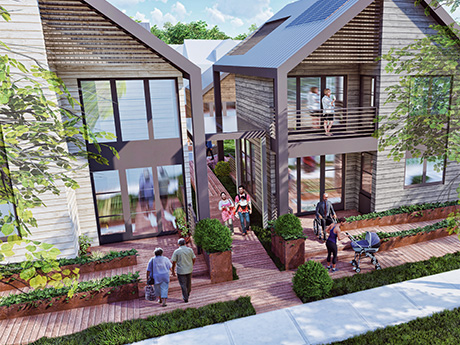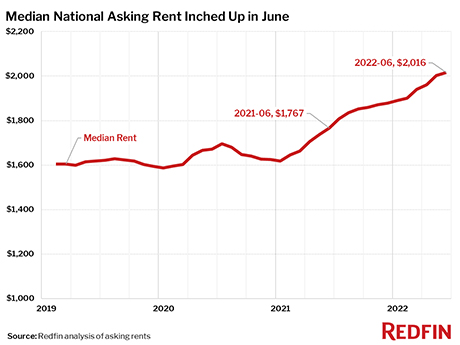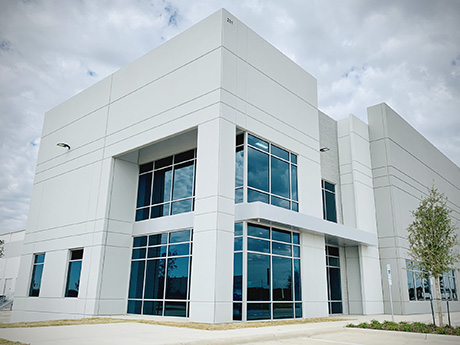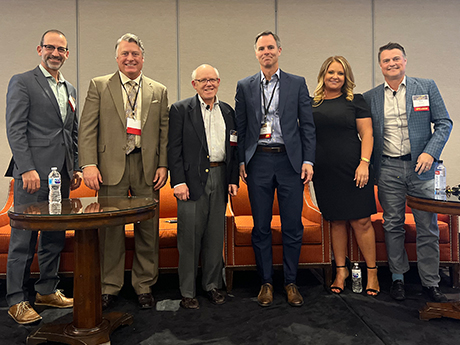By Carol Cole, director of interior design, DAHLIN Group Architecture AT Intergenerational households are growing at a faster pace than they were pre-pandemic. Generations United, a nonprofit dedicated to supporting intergenerational programs and policies, estimates that 66.7 million U.S. adults live in a multigenerational household, with nearly 57 percent of this statistic spurred by COVID. Even after the immediate impacts of the pandemic subside, intergenerational living will remain prevalent for a variety of reasons. These can range from the need for child and/or elder care to cultural expectations and economic-related factors, such as loss of a job, high educational expenses or housing availability. Considering this trend and recognizing that more than 16 million Americans are currently over the age of 65, the movement toward incorporating universal design strategies on residential projects is key for creating aesthetic living spaces that are usable by everyone to the greatest extent possible. Already a standard in the healthcare community, universal design is the design and composition of a space set up to meet the needs of all users, not as a special requirement to benefit only a small fraction of a population. The practice results in inclusive environments that support high-functioning, independent living for …
Western Feature Archive
SEATTLE — Redfin, the residential real estate brokerage giant, has reported that the national median asking rent in June is $2,016 per month, a 14.1 percent increase year-over-year. The Seattle-based company analyzed data from 20,000 separate multifamily and single-family properties from its RentPath platform across the top 50 U.S. metro areas. The June figure is a slight increase from May at 0.7 percent, which represents the smallest month-over-month gain since the start of the year. The median asking rate is also the smallest annual increase since October 2021. Daryl Fairweather, Redfin’s chief economist, says while still elevated, the current slowdown in rent growth could be anticipatory on the part of landlords in reaction to overall inflation. (The Consumer Price Index saw its biggest annual gain since 1981 in May, according to the U.S. Bureau of Labor Statistics). “Rent growth is likely slowing because landlords are seeing demand start to ease as renters get pinched by inflation,” says Fairweather. “With the cost of gas, food and other products soaring, renters have less money to spend on housing.” “This slowdown in rent increases is likely to continue, however rents are still climbing at unprecedented rates in strong job markets like New York …
SANTA BARBARA, CALIF. — The student housing industry continued to show strong fundamentals in the first quarter of this year, with preleasing levels off to a robust start and annual rent growth exceeding pre-pandemic levels, according to the latest installment of Yardi’s National Student Housing Report. As of March, preleasing for fall 2022 was reported at 63.8 percent — a number that is 13.5 percent higher than the same time last year and 9.9 percent higher than March 2019 — and the average rent per-bedroom for fall 2022 is $777. These figures are based on the company’s “Yardi 200” markets, which include the top 200 investment-grade universities across all major collegiate conferences, including the Power 5 conferences and Carnegie R1 and R2 universities (research universities in the Carnegie Classification of Institutions of Higher Education). A handful of university markets were almost fully preleased as of March, with Purdue University (99.9 percent preleased), the University of Pittsburgh (99.8 percent preleased) and the University of Wisconsin-Madison (98.3 percent preleased) topping the list. Few universities are struggling with fall 2022 preleasing so far, but those that are tend to have higher acceptance rates, according to the report. The University of Houston had the …
SANTA BARBARA, CALIF. — The national average for in-place industrial rents across the top 30 U.S. markets reached $6.45 per square foot in February, a 4.4 percent year-over-year increase according to research from CommercialEdge, a product of Yardi Systems. The Santa Barbara-based firm found that the average effective rental rates signed over the same interval was $7.35 per square foot, 90 cents higher than the national average for in-place leases, a nearly 14 percent swing. Southern California markets led the nation in rent expansion, largely due to intense activity in the Ports of Los Angeles and Long Beach. Orange County recorded the most significant 12-month change with a 7 percent hike, reaching $11.65 per square foot. Los Angeles (6.7 percent) and the Inland Empire (6.5 percent) rounded out the top three markets nationally. On the other end of the spectrum, markets that have higher availability of developable land recorded weaker rent growth in the last 12 months. Newly delivered stock in these markets is helping developers meet demand, while also elevating vacancy levels. Across the top 30 U.S. markets, rent growth was slowest in Charlotte (1.1 percent), Houston (1.7 percent) and Indianapolis (2.3. percent). The spread between the average lease …
LOS ANGELES — After bottoming out at 78.7 percent in the second quarter of 2021, private-pay seniors housing occupancy has been on a slow, steady climb, according to data from the National Investment Center for Seniors Housing and Care (NIC). The most recent data — for the fourth quarter of 2021 — showed occupancy at 81 percent. However, the pace of recovery varies widely among individual markets, individual companies and even individual properties. “Some people are able to manage the turmoil. Some are even thriving, or at least doing pretty well,” said J.P. LoMonaco, president of Valuation & Information Group. “Other people are really floundering. The questions I’m getting all revolve around occupancy, inflation, maintaining margins and revenue growth.” LoMonaco’s comments came as moderator during a panel titled, “The Power Panel: CEOs Discuss the State of the Industry” at France Media’s InterFace Seniors Housing West conference in Los Angeles on Feb. 24. Nearly 225 industry professionals attended the event. Other panelists included Chris Belford, CEO, Sinceri Senior Living; Rob Leinbach, principal, Cadence Living; Bill Pettit, president, R.D. Merrill Co.; Courtney Siegel, president and CEO, Oakmont Management Group; and Dave Sedgwick, president and CEO, CareTrust REIT. All the panelists reported their …
Company NewsFeaturesHeartland Feature ArchiveHospitalityIndustrialMixed-UseMultifamilyNortheast Feature ArchiveOfficeRetailSoutheast Feature ArchiveTexas & Oklahoma Feature ArchiveWestern Feature Archive
Forecast Survey: What’s Your Take on Commercial Real Estate in 2022?
by John Nelson
The editors of REBusinessOnline.com are conducting a brief online survey to gauge market conditions in 2022, and we welcome your participation. The survey should only take a few minutes to complete. Questions range from property sectors that you are most bullish on heading into 2022 to trends in deal volume to your outlook for interest rates. The results of our 11th annual survey will be collated and published in the January issues of our regional magazines. Conducting these surveys is part of our mission at France Media to provide readers with indispensable information, and we couldn’t do it without your help. To participate in our broker/agent survey, click here. To participate in our developer/owner/manager survey, click here. To participate in our lender/financial intermediary survey, click here. (Note: Please remember to click on “done” to properly submit the survey.)
Content PartnerDevelopmentFeaturesHeartland Feature ArchiveHospitalityIndustrialLeasing ActivityLee & AssociatesMarket ReportsMidwestMultifamilyNortheastNortheast Feature ArchiveOfficeRetailSoutheastSoutheast Feature ArchiveTexasTexas & Oklahoma Feature ArchiveWesternWestern Feature Archive
Lee & Associates Breaks Down Third-Quarter Economic Outlook by Sector
The calculus for which asset classes are likeliest to demonstrate strong growth continues to shift as the pandemic appears to be receding. Patterns in labor shortages, supply chain issues and material costs have managed to solidify through the third quarter of 2021. Lee & Associates’ newly released Q3 2021 North America Market Report dissects third-quarter 2021 industrial, office, retail and multifamily findings, with a focus on where demand is moving and the challenges facing each asset class. Lee & Associates has made the full market report available at this link (with further breakdowns of factors like vacancy rates, market rents, inventory square footage and cap rates by city). Below is a bird’s-eye overview of four commercial real estate asset classes as general categories, broken down to frame each through the trends and complications they faced up to the fourth quarter, according to Lee & Associates’ research. Industrial: Q3 Posts More Record Demand Pandemic-fueled consumer spending drove up third-quarter demand for warehouse and distribution facilities that eclipsed previous records. And despite a nationwide surge in new construction, some metros can barely accommodate the pace of tenant expansion. Additionally, year-over-year rent growth is at a record 6.7 percent for the industrial property sector …
Newport Beach, Calif.-based CapRock Partners was busy before the pandemic, but shows no signs of slowing down even as brick-and-mortar retail reopens. The industrial investor, developer and asset manager’s newest venture is also its biggest: a 183-acre infill project in Phoenix where it plans to build an eight-building industrial complex that totals more than 3.4 million square feet. “Several years prior to the pandemic, we recognized the ecommerce trends along with the demand for larger logistics facilities and subsequently made investments in buildings and land positions in order to capture a segment of that demand,” says Bob O’Neill, CapRock’s senior vice president of acquisitions. “In the 16 months since the onset of the pandemic, our growth has accelerated.” Phoenix’s Industrial Market Rises CapRock has added about 4.8 million square feet of Phoenix-area industrial product to its portfolio since the pandemic’s onset. Its total pipeline in the Valley is now close to 6 million square feet, with its Phoenix-area acquisition closing in 2017. Aside from CapRock, Cushman & Wakefield also appears to be bullish on Phoenix’s industrial market. The firm projects Phoenix’s preliminary industrial absorption to be about 12 million square feet for the first half of 2021. This compares to …
AcquisitionsCaliforniaContent PartnerDevelopmentFeaturesIndustrialLee & AssociatesLoansWesternWestern Feature Archive
Growing Southern California Industrial Demand Creates Shifts in Strategy, Outlook
Industrial real estate in Southern California has become what one might conservatively call a “fast-paced atmosphere.” The presence of multiple offers, sellers pushing up values and buyers continuing to chase deals have made for constantly increasing values and activity. Christopher J. Destino, SIOR, principal at Lee & Associates, spoke to REBusinessOnline about making strategic decisions in this unusual environment. REBusiness: What is the forecast for demand in industrial properties in Southern California? Destino: The future of demand in the area is very strong, with developers seeking new sites aggressively and underwriting steady future rent growth over the next couple of years. A lot of that is driven by e-commerce, and there’s still so much room to grow in the e-commerce world. E-commerce accounted for approximately 13.6 percent of retail sales in the first quarter of 2021 (a number that is steadily increasing). There is still a lot of room for that percent to increase, and that’s what is driving most industrial demand. REBusiness: What are the types of tenants have the most demand for space right now? Destino: The big three are distribution companies, contractors and service-type industries. There is a still a small manufacturing base, but those are the …
Affordable HousingBuild-to-RentFeaturesMultifamilySeniors HousingSingle-Family RentalStudent HousingWestern Feature Archive
‘Astronomical’ Multifamily Investment Demand Drives Up Pricing, Says Marcus & Millichap’s IPA Panel
by John Nelson
The U.S. multifamily sector remains an attractive option for real estate investors looking for a safe haven. Beyond the pool of traditional buyers who are actively acquiring apartment properties, the sector has become a landing spot for companies that aren’t legacy multifamily owners. Steven DeFrancis, CEO of Cortland, cited REITs like Blackstone Real Estate Investment Trust as newly establishing a presence in the multifamily sector. BREIT recently made a $240 million preferred equity investment in Tricon Residential connected with Tricon’s purchase of single-family rental (SFR) homes in Nashville. Nuveen Real Estate is also a recent institutional investor entrant in the emerging SFR sector. “We’re seeing a lot of new capital, whether it’s coming from overseas or from here,” said DeFrancis. “Institutional capital is continuing to move into real estate, and then within real estate there’s a lot of movement from other sectors into multifamily.” Jessica Levin, senior director of acquisitions at Intercontinental Real Estate Corp., said that the influx of capital into the U.S. apartment market the past six months has been “astronomical.” She also said that there’s no slowdown ahead. “Competition is stiffer now than in the past 10 to 15 years, and it’s only going to increase from …











